Gigantic stone head of Negritic African
during the Olmec (Xi) Civilization
By Paul Barton 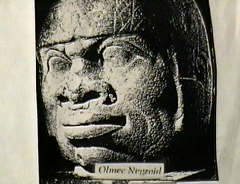 The earliest people in the Americas were people of the Negritic African race, who entered
the Americas perhaps as early as 100,000 years ago, by way of the bering straight and about thirty thousand years ago in a
worldwide maritime undertaking that included journeys from the then wet and lake filled Sahara towards the Indian Ocean and
the Pacific, and from West Africa across the Atlantic Ocean towards the Americas. The earliest people in the Americas were people of the Negritic African race, who entered
the Americas perhaps as early as 100,000 years ago, by way of the bering straight and about thirty thousand years ago in a
worldwide maritime undertaking that included journeys from the then wet and lake filled Sahara towards the Indian Ocean and
the Pacific, and from West Africa across the Atlantic Ocean towards the Americas.
According to the Gladwin Thesis, this
ancient journey occurred, particularly about 75,000 years ago and included Black Pygmies, Black Negritic peoples and Black
Australoids similar to the Aboriginal Black people of Australia and parts of Asia, including India.
Ancient African terracotta portraits 1000 B.C. to 500 B.C. 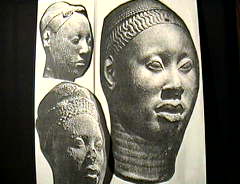 Recent discoveries in the field of linguistics and other methods have shown without a
doubt, that the ancient Olmecs of Mexico, known as the Xi People, came originally from West Africa and were of the Mende African
ethnic stock. According to Clyde A. Winters and other writers (see Clyde A. Winters website), the Mende script was discovered
on some of the ancient Olmec monuments of Mexico and were found to be identical to the very same script used by the Mende
people of West Africa. Although the carbon fourteen testing date for the presence of the Black Olmecs or Xi People is about
1500 B.C., journies to the Mexico and the Southern United States may have come from West Africa much earlier, particularly
around five thousand years before Christ. That conclusion is based on the finding of an African native cotton that was discovered
in North America. It's only possible manner of arriving where it was found had to have been through human hands. At that period
in West African history and even before, civilization was in full bloom in the Western Sahara in what is today Mauritania.
One of Africa's earliest civilizations, the Zingh Empire, existed and may have lived in what was a lake filled, wet and fertile
Sahara, where ships criss-crossed from place to place. Recent discoveries in the field of linguistics and other methods have shown without a
doubt, that the ancient Olmecs of Mexico, known as the Xi People, came originally from West Africa and were of the Mende African
ethnic stock. According to Clyde A. Winters and other writers (see Clyde A. Winters website), the Mende script was discovered
on some of the ancient Olmec monuments of Mexico and were found to be identical to the very same script used by the Mende
people of West Africa. Although the carbon fourteen testing date for the presence of the Black Olmecs or Xi People is about
1500 B.C., journies to the Mexico and the Southern United States may have come from West Africa much earlier, particularly
around five thousand years before Christ. That conclusion is based on the finding of an African native cotton that was discovered
in North America. It's only possible manner of arriving where it was found had to have been through human hands. At that period
in West African history and even before, civilization was in full bloom in the Western Sahara in what is today Mauritania.
One of Africa's earliest civilizations, the Zingh Empire, existed and may have lived in what was a lake filled, wet and fertile
Sahara, where ships criss-crossed from place to place.
ANCIENT AFRICAN KINGDOMS PRODUCED
OLMEC TYPE CULTURES
The
ancient kingdoms of West Africa which occupied the Coastal forest belt from Cameroon to Guinea had trading relationships with
other Africans dating back to prehistoric times. However, by 1500 B.C., these ancient kingdoms not only traded along the Ivory
Coast, but with the Phoenicians and other peoples. They expanded their trade to the Americas, where the evidence for an ancient
African presence is overwhelming. The kingdoms which came to be known by Arabs and Europeans during the Middle Ages were already
well established when much of Western Europe was still inhabited by Celtic tribes. By the 5th Century B.C., the Phoenicians
were running comercial ships to several West African kingdoms. During that period, iron had been in use for about one thousand
years and terracotta art was being produced at a great level of craftsmanship. Stone was also being carved with naturalistic
perfection and later, bronze was being used to make various tools and instruments, as well as beautifully naturalistic works
of art.
The ancient West African coastal and interior Kingdoms occupied an area that is now
covered with dense vegetation but may have been cleared about three to four thousand years ago. This includes the regions
from the coasts of West Africa to the South, all the way inland to the Sahara. A number of large kingdoms and empires existed
in that area. According to Blisshords Communications, one of the oldest empires and civilizions on earth existed just north
of the coastal regions into what is today Mauritania. It was called the Zingh Empire and was highly advanced. In fact, they
were the first to use the red, black and green African flag and to plant it throughout their territory all over Africa and
the world.
The Zingh Empire existed about fifteen thousand years ago. The only other civilizations that may have been
in existance at that period in history were the Ta-Seti civilization of what became Nubia-Kush and the mythical Atlantis civilization
which may have existed out in the Atlantic, off the coast of West Africa about ten to fifteen thousand years ago. That leaves
the question as to whether there was a relationship between the prehistoric Zingh Empire of West Africa and the civilization
of Atlantis, whether the Zingh Empire was actually Atlantis, or whether Atlantis if it existed was part of the Zingh empire.
Was Atlantis, the highly technologically sophisticated civilization an extension of Black civilization in the Meso-America
and other parts of the Americas?
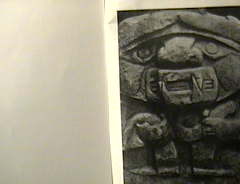
Stone carving of a Shaman or priest
from Columbia's San Agustine Culture
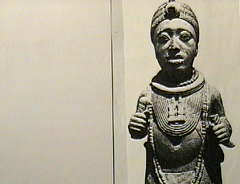
An ancient West African Oni or King holding similar artifacts
as the San Agustine
culture stone carving of a Shaman
The above ancient stone carvings (500
t0 1000 B.C.) of Shamans of Priest-Kings clearly show distinct similarities in instruments held and purpose. The realistic
carving of an African king or Oni and the stone carving of a shaman from Columbia's San Agustin Culture indicates diffusion
of African religious practices to the Americas. In fact, the region of Columbia and Panama were among the first places that
Blacks were spotted by the first Spanish explorers to the Americas.
|
From the archeological evidence gathered both in West Africa and Meso-America, there
is reason to believe that the African Negritics who founded or influenced the Olmec civilization came from West Africa. Not
only do the collosol Olmec stone heads resemble Black Africans from the Ghana area, but the ancient religious practices of
the Olmec priests was similar to that of the West Africans, which included shamanism, the study of the Venus complex which
was part of the traditions of the Olmecs as well as the Ono and Dogon People of West Africa. The language connection is of
significant importance, since it has been found out through decipherment of the Olmec script, that the ancient Olmecs spoke
the Mende language and wrote in the Mend script, which is still used in parts of West Africa and the Sahara to this day.
ANCIENT
TRADE BETWEEN THE AMERICAS AND AFRICA
The earliest trade and commercial activities between prehistoric and ancient
Africa and the Americas may have occurred from West Africa and may have included shipping and travel across the Atlantic.
The history of West Africa has never been properly researched. Yet, there is ample evidence to show that West Africa of 1500
B.C. was at a level of civilization approaching that of ancient Egypt and Nubia-Kush. In fact, there were similarities between
the cultures of Nubia and West Africa, even to the very similarities between the smaller scaled hard brick clay burial pyramids
built for West African Kings at Kukia in
pre Christian Ghana and their counterparts in Nubia, Egypt and Meso-America.
Although
West Africa is not commonly known for having a culture of pyramid-building, such a culture existed although pyramids were
created for the burial of kings and were made of hardened brick. This style of pyramid building was closer to what was built
by the Olmecs in Mexico when the first Olmec pyramids were built. In fact, they were not built of stone, but of hardened clay
and compact earth.
Still, even though we don't see pyramids of stone rising above the ground in West Africa, similar
to those of Egypt, Nubia or Mexico, or massive abilisks, collosal monuments and structures of Nubian and Khemitic or Meso-American
civilization. The fact remains, they did exist in West Africa on a smaller scale and were transported to the Americas, where
conditions
such as an environment more hospitable to building and free of detriments such as malaria and the tsetse fly,
made it much easier to build on a grander scale.
|
|
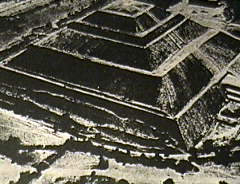
Meso-American pyramid with stepped appearance,
built about 2500 years ago
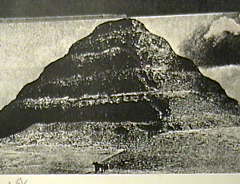
Stepped Pyramid of Sakkara, Egypt, built over
four thousand years ago, compare
to Meso-American pyramid
Large scale building projects such as monuent
and pyramid building was most likely carried to the Americas by the same West Africans who developed the Olmec or Xi civilization
in Mexico. Such activities would have occurred particularly if there was not much of a hinderance and obstacle to massive,
monumental building and construction as there was in the forest and malaria zones of West Africa. Yet, when the region of
ancient Ghana and Mauritania is closely examined, evidence of large prehistoric towns such as Kukia and others as well as
various monuments to a great civilization existed and continue to exist at a smaller level than Egypt and Nubia, but significant
enough to show a direct connection with Mexico's Olmec civilization.
The similarities between Olmec and West African
civilization includes racial, religious and pyramid bilding similarities, as well as the similarities in their alphabets and
scripts as well as both cultures speaking the identical Mende language, which was once widespread in the Sahara and was spread
as far East as Dravidian India in prehistoric times as well as the South Pacific.
During the early years of West African
trade with the Americas, commercial seafarers made frequent voyages across the Atlantic. In fact, the oral history of a tradition
of seafaring between the Americas and Africa is part of the history of the Washitaw People, an aboriginal Black nation who
were the original inhabitants of the Mississippi Valley region, the former Louisiana Territories and parts of the Southern
United States. According to their oral traditions, their ancient ships criss-crossed the Atlantic Ocean between Africa and
the Americas on missions of trade and commerce..
Some of the ships used during the ancient times, perhaps earlier than
7000 B.C. (which is the date given for cave paintings of the drawings and paintings of boats in the now dried up Sahara desert)
are similar to ships used in parts of Africa today. These ships were either made of papyrus or planks lashed with rope, or
hollowed out tree trunks.
These ancient vessels were loaded with all type of trade goods and not only did they criss-cross
the Atlantic but they traded out in the Pacific and settled there as well all the way to California. In
fact, the tradition
of Black seafarers crossing the Pacific back and forth to California is much older than the actual divulgance of that fact
to the first Spanish explorers who were told by the American Indians that Black men with curly hair made trips from California's
shores to the Pacific on missions of trade.
On the other hand, West African trade with the Americas before Columbus
and way back to proto historic times (30,000 B.C. to 10,000 B.C.), is one of the most important chapters in ancient African
history. Yet, this era which begun about 30,000 years ago and perhaps earlier (see the Gladwin Thesis, by C.S.Gladwin, Mc
Graw Hill Books), has not been part of the History of Blacks in the Americas. Later on in history, particularly during the
early Bronze Age.
However, during the latter part of the Bronze Age, particularly between 1500 B.C. to 1000 B.C., when
the Olmec civilization began to bloom and flourish, new conditions in the Mediterranean made it more difficult for West Africans
to trade by sea with the region, although their land trade accross the Sahara was flourishing. By then, Greeks, Phoenicians,
Assyrians, Babylonians and others were trying to gain control of the sea routes and the trading ports of the region. Conflicts
in the region may have pushed the West Africans to strengthen their trans-Atlantic trade with the Americas and to explore
and settle there.
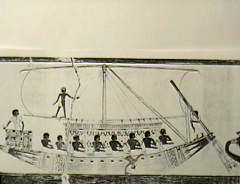
Ancient sea-going vessel used by the Egyptians
and Nubians in ancient times.
|
West African Trade and Settlement in the Americas Increases Due to Conflicts in the Mediterranean The flowering of the Olmec Civilization occurred between 1500 B.C. to 1000 B.C., when over twenty-two collosal
heads of basalt were carved representing the West African Negritic racial type.
This flowering continued with the appearance
of "Magicians," or Shamanistic Africans who observed and charted the Venus planetary complex (see the pre-Christian era statuette
of a West African Shaman in the photograph above)
These "Magicians," are said to have entered Mexico from West Africa between
800 B.C. to 600 B.C. and were speakers of the Mende language as well as writers of the Mende script or the Bambara script,
both which are still used in parts of West Africa and the Sahara.
These Shamans who became the priestly class at Monte
Alban during the 800's to 600's B.C. ( ref. The History of the African-Olmecs and Black Civilization of the Americas From
Prehistoric Times to the Present Era), had to have journied across the Atlantic from West Africa, for it is only in West Africa,
that the religious practices and astronomical and religious practices and complex (Venus, the Dogon Sirius observation and
the Venus worship of the Afro-Olmecs, the use of the ax in the worship of Shango among he Yoruba of West Africa and the use
of the ax in Afro-Olmec worship as well as the prominence of the thunder God later known as Tlalock among the Aztecs) are
the same as those practiced by the Afro-Olmec Shamans. According to Clyde Ahmed Winters (see "Clyde A. Winters" webpage on
"search."
Thus, it has been proven through linguistic studies, religious similarities, racial similarities between
the Afro-Olmecs and West Africans, as well as the use of the same language and writing script, that the Afro-Olmecs came from
the Mende-Speaking region of West Africa, which once included the Sahara.
Sailing and shipbuilding in the Sahara is
over twenty thousand years old. In fact, cave and wall paintings of ancient ships were displayed in National Geographic Magazine
some years ago. Such ships which carried sails and masts, were among the vessels that swept across the water filled Sahara
in prehistoric times. It is from that ship-building tradition that the Bambara used their knowledge to build Thor Hayerdhal's
papyrus boat Ra I which made it to the West Indies from Safi in Morroco years ago. The Bambara are also one of the West African
nationalities who had and still have a religious and astronomical complex similar to that of the ancient Olmecs, particularly
in the area of star gazing.
A journey across the Atlantic to the Americas on a good current during clement weather
would have been an easier task to West Africans of the Coastal and riverine regions than it would have been through the use
of caravans criss-crossing the hot by day and extremely cold by night Sahara desert. It would have been much easier to take
a well made ship, similar to the one shown above and let the currents take it to the West Indies, and may have taken as long
as sending goods back and forth from northern and north-eastern Africa to the interior and coasts of West Africa's ancient
kingdoms. Add to that the fact that crossing the Sahara would have been no easy task when obsticales such as the hot and dusty
environment, the thousands of miles of dust, sand and high winds existed. The long trek through the southern regions of West
Africa through vallies, mountains and down the many rivers to the coast using beasts of burden would have been problematic
particularly since malaria mosquitoes harmful to both humans and animals would have made the use of animals to carry loads
unreliable.
Journeys by ship along the coast of West Africa toward the North, through the Pillars of Heracles,
eastward
on the Mediterran to Ports such as Byblos in Lebanon, Tyre or Sydon would have been two to three times as lengthy as taking
a ship from Cape Verde, sailing it across the Atlantic and landing in North-Eastern Brazil fifteen hundred miles away, or
Meso America about 2400 miles away. The distance in itself is not what makes the trip easy. It is the fact that currents
which
are similar to gigantic rivers in the ocean, carry ships and other vessels from West Africa to the Americas with relative
ease.
West Africans during the period of 1500 B.C. to 600 B.C. up to 1492 A.D. may have looked to the Americas as a
source of trade, commerce and a place to settle and build new civlilzations. During the period of 1500 B.C. to 600 B.C., there
were many conflicts in the Mediterranean involving the Kushites, Egyptians, Assyrians, Phoenicians, Sea Peoples, Persians,
Jews and others. Any kingdom or nation of that era who wanted to conduct smoothe trade without complications would have tried
to find alternative trading partners. In fact, that was the very reason why the Europeans decided to sail westwared in their
wearch for India and China in 1492 A.D. They were harrassed by the Arabs in the East and had to pay heavy taxes to pass through
the region.
Still, most of the Black empires and kingdoms such as Kush, Mauri, Numidia, Egypt, Ethiopia and others
may have had little difficulty conducting trade among their neighbors since they also were among the major powers of the region
who were dominant in the Mediterranean.
South of this northern region to the south-west, Mauritania (the site of the prehistoric
Zingh Empire) Ghana, and many of the same nationalities who ushered in the West African renaissance of the early Middle Ages
were engaged in civilizations and cultures similar to those of Nubia, Egypt and the Empires of the Afro-Olmec or Xi (Shi)
People.
|
Nubian-Kushite King and Queen (circa 1000 B.C.) 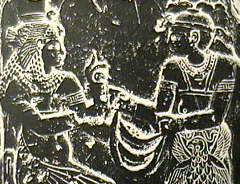 It is believed that there was a Nubian presence in Mexico and that the West African civilizations
were related to that of the Nubians, despite the distance between the two centers of Black civilization in Africa. There is
no doubt that in ancient times there were commercial ties between West Africa and Egypt. In fact, about 600 B.C., Nikau, a
Pharaoh of Egypt sent ships to circumnavigate Africa and later on about 450 B.C., Phoenicians did the same, landing in West
Africa in the nation now called Cameroon. There they witnessed what may have been the celebration of a Kwanza-like harvest
festival, where "cymbals, horns," and other instruments as well as smoke and fire from buring fields could be seen from their
ships. It is believed that there was a Nubian presence in Mexico and that the West African civilizations
were related to that of the Nubians, despite the distance between the two centers of Black civilization in Africa. There is
no doubt that in ancient times there were commercial ties between West Africa and Egypt. In fact, about 600 B.C., Nikau, a
Pharaoh of Egypt sent ships to circumnavigate Africa and later on about 450 B.C., Phoenicians did the same, landing in West
Africa in the nation now called Cameroon. There they witnessed what may have been the celebration of a Kwanza-like harvest
festival, where "cymbals, horns," and other instruments as well as smoke and fire from buring fields could be seen from their
ships.
At that period in history, the West African cultures and civilizations, which were offshoots of much earlier
southern Saharan cultures, were very old compared to civilizations such as Greece or Babylon. In fact, iron was being used
by the ancient West Africans as early as 2600 years B.C. and was so common that there was no "bronze age" in West Africa,
although bronze was used for ornaments and instruments or tools.
A combination of Nubians and West Africans engaged
in mutual trade and commerce along the coasts of West Africa could have planned many trips to and from the Americas and could
have conducted a crossing about 1500 B.C. and afterwards. Massive sculptures of the heads of typical Negritic Africans were
carved in the region of South Mexico where the Olmec civilization flourished. Some of these massive heads of basalt contain
the cornrow hairstyle common among West African Blacks, as well as the kinky coiled hair common among at least 70 percent
of all Negritic people, (the other proportion being the Dravidian Black race of India and the Black Australoids of Australia
and South Asia).
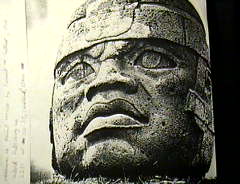
Collossol Afro-Olmec head of basalt wearing
Nubian type war helmet, circa 1100
B.C.
Afro-Olmecs Came from the Mende Regions of West Africa Although archeologists
have used the name "Olmec," to refer to the Black builders of ancient Mexico's first civilizations, recent discoveries have
proven that these Afro-Olmecs were West Africans of the Mende language and cultural group. Inscriptions found on ancient monuments
in parts of Mexico show that the script used by the ancient Olmecs was identical to that used by the ancient and modern Mende-speaking
peoples of West Africa. Racially, the collosal stone heads are identical in features to West Africans and the language deciphered
on Olmec monuments is identical to the Mende language of West Africa, (see Clyde A. Winters) on the internet.
The term
"Olmec" was first used by archeologists since the giant stone heads with the features of West African Negritic people were
found in a part of Mexico with an abundance of rubber trees. The Maya word for rubber was "olli, and so the name "Olmec,"
was used to label the Africoid Negritic people represented in the faces of the stone heads and found on hundreds of terracotta
figurines throughout the region.
Yet, due to the scientific work done by deciphers and linguists, it has been found
out that the ancient Blacks of Mexico know as Olmecs, called themselves the Xi People (She People).
Apart from the giant
stone heads of basalt, hundreds of terracotta figurines and heads of people of Negritic African racial reatures have also
been found over the past hundred years in Mexico and other parts of Meso-America as well as the ancient Black-owned lands
of the Southern U.S. (Washitaw Proper,(Texas, Louisiana, Mississippi, Oklahoma, Arkansas), South America's Saint Agustin Culture
in the nation of Colombia, Costa Rica, and other areas) the "Louisiana Purchase,"
lands, the south-eastern kingdom of the
Black Jamassee, and other places including Haiti, see
the magazine Ancient American).
Various cultural clues and
traces unique to Africa as well as the living descendants of prehistoric and ancient African migrants to the Americas continue
to exist to this very day. The Washitaw Nation of Louisiana is one such group (see www.Hotep.org), the Garifuna or Black Caribs of the Caribbean and Central America is another, the descendants of the Jamasse who live in
Georgia and the surrounding states is another group. There are also others such as the Black Californian of Queen Calafia
fame (the Black Amazon Queen mentioned in the book Journey to Esplandian, by Ordonez de Montalvo during the mid 1500's).
Cultural
artefacts which connect the ancient Blacks of the Americas with Africa are many. Some of these similarities can be seen in
the stone and terracotta works of the ancient Blacks of the Americas. For example, the African hairline is clearly visible
in some stone and terracotta works, including the use of cornrows, afro hair style, flat "mohawk" style similar to the type
used in Africa, dreadlocks, braided hair and even plain kinky hair. The African hairline is clearly visible on a fine stone
head from Veracruz Mexico, carved between 600 B.C. to 400 B.C., the Classic Period of Olmec civilization. That particular
statuette is about twelve inches tall and the distance from the head to the chin is about 17 centemeters. Another head of
about 12 inches, not only posesses Negroid features, but the hair design is authentically West African and is on display at
the National Museum of Mexico. This terracotta Africoid head also wears the common disk type ear plugs common in parts of
Africa even today among tribes such as the Dinka and Shilluk.
One of the most impressive pieces of evidence which show
a direct link between the Black Olmec or Xi People of Mexico and West Africans is the presence of scarification marks on some
Olmec terracotta sculpture. These scarification marks clearly indicate a West African Mandinka (Mende) presence in prehistoric
and ancient Meso-America. Ritual scarification is still practiced in parts of Africa and among the Black peoples of the South
Pacific, however the Olmec scarification marks are not of South Pacific or Melanesian Black origins, since the patterns used
on ancient Olmec sculpture is still common in parts of Africa. This style of scarification tatooing is still used by the Nuba
and other Sudanese African people. In fact, the face of a young girl with keloid scarification on here face is identical to
the very same keloid tatoos on the face of an ancient Olmec terracotta head from ancient Mexico. Similar keloid tattoos also
appear on the arms of some Sudanese and are identical to similar keloid scars on the arms of some clay figures from ancient
Olmec terracotta figurines of Negroid peoples of ancient Mexico.
|
|
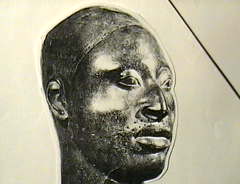
Bronze head of an ancient king from Benin, West Africa,
The tradition of fine
sculpture in West Africa goes back long before 1000 B.C.
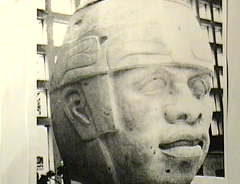
Collosal head of Afro-Olmec (Xi) warrior-king, circa 1100 B.C.
Descendants of Ancient Africans in Recent America In many parts
of the Americas today, there are still people of African Negritic racial backgrounds who continue to exist either blended
into the larger African-Americas population or are parts of separate, indigenous groups living on their own lands with their
own unique culture and languages.
One such example is the Washitaw Nation who owned about one million square miles
of the former Louisiana Territories, (see www.Hotep.org), but who now own only about 70,000 acres of all their former territory. The regaining of their lands from the U.S. was a
long process which concluded partially in 1991, when they won the right to their lands in a U.S. court.
The Black Californian
broke up as a nation during the late 1800's after many years of war with the Spanish invaders of the South West, with Mexico
and with the U.S. The blended into the Black population of California and their descendants still exist among the millions
of Black Californians of today.
The Black Caribs or Garifunas of the Caribbean Islands and Central America fought
with the English and Spanish from the late fifteen hundreds up to 1797, when the British sued for peace. The Garifuna were
expelled from their islands but they prospered in Central America where hundreds of thousands live along the coasts today.
The
Afro-Darienite is a significant group of pre-historic, pre-columbian Blacks who existed in South America and Central America.
These Blacks were the Africans that the Spanish first saw during their exploration of the narrow strip of land between Columbia
and Central America and who were described as "slaves of our lord" since the Spaniards and Europeans had the intention of
enslaving all Blacks they found in the newly discovered lands.
The above mentioned Blacks of precolumbian origins are
not Blacks wo mixed with the Mongoloid Indian population as occurred during the time of slavery. They were Blacks who were
in some cases on their lands before the southward migrations of the Mongoloid Native Americans. In many cases, these Blacks
had established civilizations in the Americas thousands of years ago.
|
|
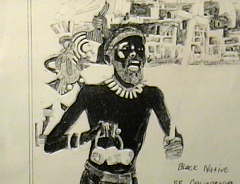
An early Black Californian, a member of the original Black
aboriginal people
of California and the South Western U.S.
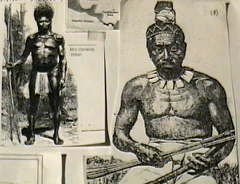
A member of one of the original Black nations of the Americas,
the Afro-Darienite
of Panama.
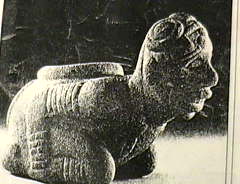
Stone carving of Negroid person found in area
close to Washitaw Territories,
Southern U.S.
|
THE USE OF ANCIENT AFRICAN SHIPS AND BOATS TO TRADE WITH THE AMERICAS Protohistoric,
prehistoric and ancient Negritic Africans were masters of the lands as well as the oceans. They were the first shipbuilders
on earth and had to have used watercraft to cross from South East Asia to Australia about 60,000 years ago and from the West
Africa/Sahara inland seas region to the Americas. The fact of the northern portion of Africa now known as a vast desert wasteland
being a place of large lakes, rivers and fertile regions with the most ancient of civilizations is a fact that has been verified,
(see African Presence in Early America, edt. Ivan Van Sertima and Runoko Rashidi, Transaction Publishers, New Bruinswick,
NJ "The Principle of Polarity," by Wayne Chandler: 1994.)
From that region of Africa as well as East Africa, diffusions
of Blacks towards the Americas as early as 30,000 B.C. are believed to have occurred based on findings in a region from Mexico
to Brazil which show that American indians in the region include Negritic types (eg. Olmecs, Afro-Darienite, Black Californians,
Chuarras, Garifunas and others). Much earlier journeys occurred by land sometime before 75,000 B.C. according to the Gladwin
Thesis written by C.S. Gladwin. This migration occurred on the Pacific side of the Americas and was began by Africans with
Affinities similar to the people of New Guinea, Tasmania, Solomon Islands and Australia. The earliest migrations of African
Blacks through Asia then to the Americas seemed to have occurred exactly during the period that the Australian Aborigines
and the proto-African ancestors of the Aborigines, Oceanic Negroids (Fijians, Solomon Islanders, Papua-New Guineans,and so
on) and other Blacks spread throughout East Asia and the Pacific Islands about one hundred thousand years ago. The fact that
these same Blacks are still among the world's seafaring cultures and still regard the sea as sacred and as a place of sustinence
is evidence of their ancient dependance on the sea for travel and exploration as well as for commerce and trade. Therefore,
they would have had to build sea-worthy ships and boats to take them across the vast expanses of ocean, including the Atlantic,
Indian Ocean (both the Atlantic and Indian Oceans were called the Ethiopean Sea, in the Middle Ages) and the Pacific Ocean.
During
the historic period close to the early bronze or copper using period of world history (6000 B.C. to 4000 B.C. migrations of
Africans from the Mende regions of West Africa and the Sahara across the Atlantic to the Americas may have occurred. In fact,
the Mende agricultural culture was well established in West Africa and the Sahara during that period. Boats still criss-crossed
the Sahara, as they had been doing for over ten thousand years previously. The ancient peoples of the Sahara, as rock paintings
clearly show, were using boats and may have sailed from West Africa and the Sahara to the Americas, including the Washitaw
territories of the Midwestern and Southern U.S. Moreover, it is believed by the aboriginal Black people of the former Washitaw
Empire who still live in the Southern U.S., that about 6000 B.C., there was a great population shift from the region of Africa
and the Pacific ocean, which led to the migrations of their ancestors to the Americas to join the Blacks who had been there
previously.
As for the use of ships, ancient Negritic peoples and the original Negroid peoples of the earth may have
began using boats very early in human history. Moreover, whatever boats were used did not have to be sophisticated or of huge
size. In fact, the small, seaworthy "outrigger" canoe may have been spread from East Africa to the Indian Ocean and the Pacific
by the earliest African migrants to Asia and the Pacific regions. Boats of papyrus, skin, sewed plank, log and hollowed logs
were used by ancient Africans on their trips to various parts of the world.
|
|
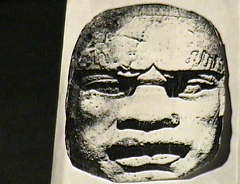
Gigantic stone head of Afro-Olmec (Xi People)
of ancient Mexico, circa 1100
B.C.
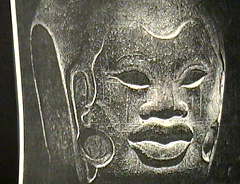
Face of Afro-Olmec child carved on the waste "belt" of an Olmec ballplayer
This stone belt was used by the Olmec ballplayers to catch the impact of the rubber balls in
their ball games. This face is typical Negritic, including the eyes which seem to "slant," a common racial characteristic
in West Africa, the Sahara and in South Africa among the Kong-San (Bushmen) and other Africans.
TRADE ROUTES OF THE ANCIENT BLACKS During the years of migrations
of Africans to all parts of the world, those who crossed the Atlantic, Indian Ocean and Pacific also used the seas to make
trips to the northern parts of Africa. They may have avoided the northern routes across the deserts at particular times of
the year and sailed northward by sailing parallel to the coastslines on their way northward or southward, just as the Phoenicians,
Nubians and Egyptians had done.
Boats made of skin, logs, hollowed ttee trunk, lashed canoes and skin could have been used
for trading and commerce.
The reed boat is a common type of watercraft used in West Africa and other parts of the world,
yet there were other boats and ships to add to those already mentioned above. Boats similar to those of Nubia and Egypt were
being used in the Sahara just as long or even longer than they were being used in Egypt. In fact, civilization in the Sahara
and Sudan existed before Egypt was settled by Blacks from the South and the Sahara.
The vessels which crossed the Atlantic
about 1500 B.C. (during the early Afro-Olmec period) were most likely the same types of ships shown in the sahara cave paintings
of ships dating to about 7,000 B.C. or similar ships from Nubian rock carvings of 3000 B.C..
Egyptologists such as
Sir Flinders Petrie believed that the ancient African drawings of ships represent papyrus boats similar to the one built by
the Bambara People for Thor Hayerdhal on the shores of Lake Chad. This boat made it to Barbadose, however they did not reinforce
the hull with rope as the ancient Egyptians and Nubians did with their ancient ships. That lack of reinforcement made the
Bambara ship weak, however another papyrus ship built by Ayamara Indians in Lake Titicaca, Bolivia was reinforced and it made
it to the West Indies without difficulty.
Naval historian Bjorn Landstrom believes that some of the curved hulls shown
on rock art and pottery from the Nubian civilization (circa 3000 B.C.) point to a basic three-plank idea. The planks would
have been sewn together with rope. The larer version must have had some interior framing to hold them together. The hulls
of some ot these boats show the vertical extension of the bow and stern which may have been to keep them bouyant.
These
types of boats are stilll in use in one of the most unlikely places. The Djuka and Saramaka Tribes of Surinam, known also
as 'Bush Negroes,"
build a style of ship and boat similar to that of the Ancient Egyptians and Nubians, with their bows
and sterns curving upward and pointing vertically.
This style of boat is also a common design in parts of West Africa,
particularly along the Niger River where extensive river trading occurs. They are usually carved from a single tree trunk
which is used as the backbone. Planks are then fitted alongside to enlarge them. In all cases, cabins are built on top of
the interior out of woven mat or other strong fiberous material. These boats are usually six to eight feet across and about
fifty feet long. There is evidence that one African Emperor Abubakari of Mali used these "almadias" or longboats to make a
trip to the Americas during the 1300's.(see, They Came Before Columbus, Ivan Van Sertima; Random House: 1975)
Apart
from the vessels used by the West Africans and south western Sahara Black Africans to sail across the Atlantic to the Americas,
Nubians, Kushites, Egyptians and Ethiopians were known traders in the Mediterranean. The Canaanites, the Negroid inhabitants
of the Levant who later became the Phoenicians also were master seafarers. This has caused some to speculate that the heads
of the Afro-Olmecs represent the heads of servants of the Phoenicians, yet no dominant people would build such massive and
collosol monuments to their servants and not to themselves.
Check for historical references and literature
ANTHROPOLOGISTS BELIEVE THERE WAS AN ANCIENT BLACK PRESENCE IN THE AMERICAS
During the International Congress
of American Anthropologists held in Bacelona, Spain in 1964, a French anthropologist pointed out that all that was missing
to prove a definite presence of Negritic Blacks in the Americas before Columbus was Negroid skeletons to add to the already
found Negroid featured terracottas. Later on February of 1975 skeletons of Negroid people dating to the 1200's were found
at a precolumbian grave in the Virgin Islands. Andrei Wierzinski, the Polish crainologist also concluded based on the study
of skeletons found in Mexico, that a good portion of the skulls were that of Negritic Blacks,
Based on the many finds
for a Black African Negroid presence in ancient Mexico, some of the most enthusiastic proponents of a pre-columbian Black
African presence in Mexico are Mexican professionals. They conclude that Africans must have established early important trading
centers on the coasts along Vera Cuz, from which Middle America's first civiliztion grew.
In retrospect, ancient Africans
did visit the Americas from as early as about 100,000 B.C. where they stayed for tens of thousands of years. By 30,000 B.C.,
to about 15,000 B.C., a massive migration from the Sahara towards the Indian Ocean and the Pacific in the East occurred from
the Sahara. Blacks also migrated Westward across the Atlantic Ocean towards the Americas during that period until the very
eve of Columbus' first journey to the Americas.
Trade, commerce and exploration as well as the search for new lands
when the Sahara began to dry up later in history was the catalyst that drove the West Africans towards the Atlantic and into
the Americas.
REFERENCES
Washitaw Nation (www.Hotep.org)
Clyde A. Winters (The Nubians and the Olmecs)
Blacks of India dalitstan.org
Blacks of the Pacific and Melanesia:
www.cwo.com/~lucumi/pacific.html
If you ever visit the ancient Afro-Olmec monuments of Mexico, the Washitaw Nation of Louisiana, the monuments of Nubia,
Egypt or West Africa you need to take great pictures:
www.photoalley.com
|
DESCENDANTS OF PRECOLUMBIAN BLACKS IN THE U.S., CARIBBEAN, CENTRAL AMERICA AND SOUTH AMERICA AND THE FIGHT
FOR THE RETURN OF THEIR STOLEN OCCUPIED LANDS IN THE MIDST OF THE REPARATIONS
DEBATE THE ISSUE OF RETURNING THE LANDS OF THESE BLACKS WHO ANCESTORS WERE HERE IN THE U.S. AND AMERICAS BEFORE COLUMBUS HAS
ALREADY BEEN DONE WITH ONE BLACK NATION OF THE LOUISIANA TERRITORIES
The experience of the Washitaw Nation
(or Ouchita Nation) of the Southern United States is another piece of solid evidence for the fact of pre-Columbian African
presence and settlement in the Americas and specifically in the United States. According to an article carried in the magazine,
'The Freedom Press Newsletter, (Spring, 1996), reprinted from Earthways, The Newsleter of the Sojourner Truth Farm School
(August, 1995), the Washitaw were
(and still are) a nation of Africans who existed in the Southern U.S. and Mississippi
Valley region long before the 16th century Europeans arrived and even before there were "Native Americans" on the lands the
Washitaw once occupied and still occupy today.
According to the article, "the Washitaw Nation "governed three million
acres of land in Louisiana,
Arkansas, Oklahoma, Texas and Mississippi. They were ship builders (similar to the Garifuna
of the Caribbean, who are also of pre-Columbian West Afrucan Mandinka Muslim origins (according to Harold Lawrence in 'African
Presence in Early America,edt. by Ivan Van Sertima).
What is even more facinating about this aspect of hidden history
of Blacks in America before Columbus is that the Washitaw Nation was known and recognized as a separate, independant Black
nation by the Spanish and French, who were in the Louisiana Territories and Texas areas. According to the present leader of
the Washitaw Nation, "when Spain ceeded the Louisiana Territory to France, they excluded the land belonging to the Washitaw
Nation. France did not include it in the "Louisiana Purchase," and according to the leader, "This land
is not part of the
United States of America." That point was made in the newspaper, "The Capitol Spotlight, June 1992.
In fact, the courts
agreed that the land was not part of the U.S. and that in fact the Washitaw (Ouchita) Nation was on the land long before European
Colonization: therefore, in legal decisions made, some of the ancient territory was returned. This historical decision was
made about 1991.
This is the type of information seldom seen in the majority press, yet, the importance of that event
clearly points to the incredible service small papers and magazines such as Ancient American or the Capitol Spotlight and
The Freedom Press Newsletter have been making, along iwth internet news and information sites such as this one. So, here we
see an example in the continental United States where Africans who came before slavery, before Columbus and thousands of years
before Christ (over six thousand years B.C., according to the Washitaw chroniclers), were engaged in boat building, seafaring,
trade and commerce in ancient times and who still exist today as a distinct Black Nation who have evidence and proof of their
ownership of millions of acres of lands in the Southern U.S. and the Mississippi Valley. The Washitaw Nation held an important
convention in June 1992, in Monroe, Louisiana and have held others since. (see www.Hotep.org for the Washitaw's point of view on their history and culture).
Yet, the Washitaw is merely one nation of the descendants
of pre-columbian Blacks from Africa and elsewhere and possibly from right here in the Americas as the very first people to
exist here, long before the development of the Mongoloid, American Indians or the Mongoloid( 15,000 B.C.) or even the Caucasian
races (30,000 B.C.). Pure Black Homosapiens began to migrate from Africa and populate the entire earth about 200,000 to 150,000
years ago, according to scientists, historians and anthropologists.
Among the other Black nations who existed in the
Americas before Columbus and long before Christ were the Jamassee (Yamassee), who had a large kingdom in the South eastern
U.S., Their descendants were among the first Blacks of pre-columbian American origins who fell victim to kidnapping for the
purpose of enslavement. Blacks of South America, the Caribbean and Central America were also attacked and enslaved based on
a Pontifax passed during the mid- 1400's by the Church hierachy giving the Europeans the go ahead to enslave all "Children
of Ham" found in the newly discovered territories. The descendants of the Jamassee are the millions of Blacks who live in
Alabama, Gerogia, South Carolina and northern Florida. They of course also have African slave ancestors, but these slaves
are the relatives of the same Africans who sailed to America of their own free will, while Europe was in the Dark Ages, and
long before Christ, for that matter.
In California, descendnats of the fierce "Black Californians" who were a Negroid
people of African racial origins and the original owners of California and the South WEST (BEFORE THE SPANISH INVSION...OR
THE CREATION OF THE MIXED RACE "HISPANIC" ETHNIC GROUP.
Many African-Americans in California are of Black Californian ancestry
and their great grand parents were among the original Black Californians who were victims of Spanish Californio enslavement
and Anglo American settler attacks. In fact, the Black Californian fought until the late 1800's to maintain control of their
ancestral lands from the settlers. THAT'S A FACT.
There are aboriginal nations of Blacks in Panama such as the Afro-Darienite
and the Choco people.
In fact, the Afro-Darienite are the remnants of the aboriginal Black nations of South and Central
America who were once hunted down to be made slaves by the Spaniards (in fact Balboa or Peter Matyr chroniclers referred to
these Blacks as "slaves of our lord," ) meaning, like Blacks in Africa, the South Pacific and elsewhere, they were eligible
for enslavement, being descended from Ham, the so-called "father of the Black race."
In Columbia's Choco Region, on
the Western side of that country, there are hundreds of thousands of Blacks, whose ancestors have been in Columbia for thousands
of years. In fact, scientists and some historians have found out that Black slaves were being kidnapped and hunted down in
Columbia and parts of South and Central America, as well as the Caribbean and U.S., by the Spaniards and others long before
they began to look for slaves in Africa. (an old painting in Natonal Geographic clearly shows a black with bow and arrow and
wearing a loin cloth, hunting along the coast of Columbia during the first voyage there by the Spaniards.
These Blacks
today of the Choco Region of Columbia are among the most oppressed of Blacks in Latin America today (See the Final Call back
issues on this topic)
Then there is the Garifuna or Kalifunami also called "Black Caribs" Being a member of the Black
Carib Nation and having done historical research, the myth of the Black Caribs being escaped slaves has been debunked. It
is true that the Black Caribs encouraged slaves from the West Indies Islands to join them and that the Black Caribs did ally
with the Mongoloid Caribs of Dominica and other parts of the West Indies, but the fact remains, that the Black Caribs were
originally Mende traders of gold and cloth, who established settlements throughout the Circum-Caribbean region, Mexico, Central
America, South America and the Southern U.S.
They had been arriving in the Americas for thousands of years, even before
they converted to Islam during the 900's A.D.. In fact, the Olmecs of ancient Mexico were Mende, they used the Mende script
(found on monments at Monte Alban, Mexico, and they named places from southern Mexico to South America with Mandinka names.
Such names sometimes sound identical to the names of places used in West Africa.
In retrospect, while the debate for
reparations increses, it is important that African-Americans know that two great injustices were committed by the Europeans.
The first was slavery, the second was the taking of Black lands and destroying Black history and culture so Blacks remain
totally ignorant of their rights to more than one third of north America. NOW YOU KNOW WHY THE SLAVEMASTERS DID NOT WANT BLACK
FOLK TO LEARN TO READ, AND WHY PLANTS ARE PLACED IN CHATROOMS AND ON FORUMS TO ATTEMPT TO DISCREDIT ANY USEFUL HISTORY AND
INFORMATION OFFERED TO BLACK PEOPLE.
Still, TRUTH SUBMERGED SHALL RISE AGAIN.
SUSU ECONOMICS THE HISTORY OF PAN-AFRICAN
TRADE, COMMERE, WEALTH AND MONEY
(A Preview of the Facinating History of the Development of Ancient Black Civilizations
Worldwide)
One of the most important aspects of Black history worldwide is the development of Black civilization due
to the early and persisten use and application of trade and commerce. Due to such early and well organized trading and commercial
systems throughout the prehistoric Black world, Blacks were able to expand throughout the world and establish the world's
first cultures and civilizations. Although it is said that Blacks migrated from the original homeland of mankind in Africa
to settle all Asia, Europe, Australia and the Americas (see Scientific American; Sept. 2000, p. 80-87...this is a recent publication),
long before the differentiation of the races from the original Negritic to Negriic, Caucasoid, Mongoloid, along with the various
mixed races such as Polynesians, Native Americans, Japanese, Malays, Mediterranean whites, East Indians (the mixed Negroid/Caucasian
type...not the pure Black pre Aryan Negritic Indians), Arabs, Latinos (Mestizos, Mullatoes, Zambos, Spaniards) and a number
of other mixed races and regional types, the purpose of the earlies migrations of Blacks from Africa to the rest of the world
was not merely following and hunting wild animals, as some theorists have claimed, but searching for commodities, like red
ocre to paint the smooth, dark skin from insects and decoration. Another purpose for the early migrations of Africans to other
parts of the world was to establish trading and commercial links to those of their own people, who had left previously. Hence,
even if the earliest migrations were after wandering herds of animals, further migrations were in search of links with their
kinsmen and women.
The migrations of Africans to all parts of the world within the past hundred thousand years
or more occurred before an other races existed. Thus, Black culture and civilization was being established when no other
"races" existed as we know them today. This is a facinating historical even, because having been homosapiens for over one
hundred thousand years, it is very possible that Blacks could have gone through many periods of cultural development and civilization
before the beginning of the Nile Valley civilization (since about 17,000 B.C.) or the Zingh Civilization of the South-Western
Sahara (15,000 B.C.), or even Atlantis (10,000 B.C.), or the building of the Sphinx (7,000 B.C.).
In fact, there is evidence
from ancient East Indian chronicles (some of these pictures are on AAWR (African American Web Ring) of the geat scientific
advancement of the Black prehistoric inhabitants of the Indus Valley Civilization (6000 b.c. to 1700 b.c), who built flying
machines, who had flushing toilets, cities on a gridlike pattern, and many of what we may call "modern" conviniences.
About
20,000 years ago, the present-day dried up and desertified Sahara had an aquatic civilization where the Africans who lived
on the edges of the giant inland sea, built large ocean-going ships. Rock paiintings of these ships can still be seen in the
Sahara (and some appeared on national geographic magazine about two years ago). (For more on the Aquatic Civilizations of
the prehistoric Sahara, see, "African Presence In Early Asia," by Ivan Van Sertima and Runoko Rashidi, Transaction Publications,
New Bruinswick, NJ).
The Africans who used these boats (which are still used today by tribes such as the Baduma of
Mali, West Africa) made of papyrus straw. These same type of boats were used to travel to the Americas, the Indian Ocean,
the South Pacific, India, East Asia and the Pacific, then to the Americas via the Pacific Ocean. In fact, the Fijians still
consider Africa's East Coast to be their very ancient homeland and Africans in East Africa have oral as well as written histories
of ancient journies towards Asia.
In ancient times, trade between Africans in Africa and those in the Indian Ocean, East
Asia and the Pacific Ocean, East Asia, the Americas, the Mediterranean, the Black Sea area and all the continents including
Australia. In all these areas, evidence of prehistoric African Blacks exist. IT IS VERY IMPORTANT TO NOTE THAT SUCH EVIDENCE
WAS AGAIN FOUND IN SOUTH AMERICA, WHERE ABOUT FIFTY SKULLS REPRESENTING NEGROID PEOPLE WERE FOUND IN BRAZIL (see Scientific
American, September 2000). However, this is no news to some Blacks, particularly those descended from the ancient prehistoric
Blacks of America, such as the Wasitaw of the Louisiana area, the descendants of the Black Californians, the Jamassee and
others; the Black Caribs of the Caribbean and Central America, the Choco Region Blacks of Columbia, South America and many
others.
This book examines the history of Black trade and commerce. It examines how money was made in ancient times
and how this legacy continued well into the colonial era to this very day.
In a time when Blacks worldwide are suffering
economically, this book clearly contributes to the knowledge and helps build the confidence needed to initiate a Black world
economic renaissance and Black economic, social, numerical and cultural development among Black Americans and Blacks elsewhere.
|
|
 |
|
|
 |
|
|
 |
|
|
|

